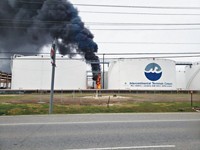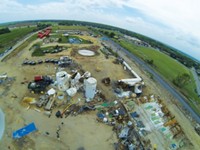Advertisement
Grab your lab coat. Let's get started
Welcome!
Welcome!
Create an account below to get 6 C&EN articles per month, receive newsletters and more - all free.
It seems this is your first time logging in online. Please enter the following information to continue.
As an ACS member you automatically get access to this site. All we need is few more details to create your reading experience.
Not you? Sign in with a different account.
Not you? Sign in with a different account.
ERROR 1
ERROR 1
ERROR 2
ERROR 2
ERROR 2
ERROR 2
ERROR 2
Password and Confirm password must match.
If you have an ACS member number, please enter it here so we can link this account to your membership. (optional)
ERROR 2
ACS values your privacy. By submitting your information, you are gaining access to C&EN and subscribing to our weekly newsletter. We use the information you provide to make your reading experience better, and we will never sell your data to third party members.
Safety
Fatal Fireworks Disposal
Failed federal oversight, lack of safety standards led to five deaths, chemical safety board finds
by Jeff Johnson
January 28, 2013
| A version of this story appeared in
Volume 91, Issue 4

Absence of government oversight of federal contractors, lack of safety standards or regulations for disposal of fireworks, and horribly unsafe workplace practices caused the death of five men working at a disposal facility for confiscated fireworks in Hawaii.
That is the conclusion of an accident investigation report by the Chemical Safety & Hazard Investigation Board (CSB) released on Jan. 17 at a public meeting in Washington, D.C. The board’s report closed the examination of an April 8, 2011, accident at the Donaldson Enterprises Inc. facility in Waipahu near Honolulu.
Donaldson was subcontracted by VSE Corp. of Alexandria, Va., which is federally contracted by the Treasury Department to dispose of confiscated material, including fireworks. As the primary contract holder, VSE is responsible for overseeing the disposal operations. The involved fireworks were professional-grade and illegally labeled for consumer use by a Chinese manufacturer, which led to their seizure by federal customs agents upon entry to the U.S. via Hawaiian ports.
A small, 20-person company, Donaldson specializes in destroying military munitions by controlled, in-place explosions. It had no experience with disassembling and destroying fireworks. VSE ignored this lack of experience as well as the lack of a safety plan when it awarded Donaldson a contract on the basis of its experience with munitions, notes CSB investigator Amanda Johnson.
“It was a local company already storing the seized fireworks in a hillside magazine,” Johnson says. “Its proposal was the lowest in cost and considered to be the most time efficient, despite [the firm] having no experience with fireworks disposal.”

The April 2011 explosion and fire occurred in a cavelike storage magazine that Donaldson was using to hold more than 50 pallets of seized contraband fireworks awaiting disposal. On the morning of the incident, five company personnel were disassembling 1-inch-diameter contraband firework tubes on a cement loading dock located directly in front of the magazine entrance, while a sixth worker remained inside the magazine.
The process the workers used to disassemble the fireworks involved cutting into the individual firework tubes by hand using a pipe cutter or knife. They then separated the individual explosive components contained within each tube including the aerial shells and the black powder. The black powder, a mix of potassium nitrate, sulfur, and charcoal, was collected and put in cardboard boxes.
According to witness statements, around 8:30 AM it began to rain heavily, and the workers quickly moved materials involved in the disassembly process—including tools, chairs, and boxes containing aerial shells, black powder, and partially disassembled firework tubes—to an area just inside the magazine entrance. Five of the workers remained inside, but the project supervisor stepped outside to make a phone call.
While he was on the phone, an explosion and fire occurred inside the magazine when an ignition source triggered the stored fireworks, black powder, diesel fuel, or any of many sources of explosive material stored in the magazine. Three Donaldson employees received fatal burn injuries and two succumbed to carbon monoxide poisoning, according to CSB. The project supervisor sustained minor injuries but survived.
The accident was completely avoidable, stresses CSB Chair Rafael Moure-Eraso. “Our investigation found that company personnel had no specific expertise in fireworks disposal, that the company’s procedures were extremely unsafe, and that there are no national standards or accepted good practices for disposing of fireworks. Fireworks provide entertainment for millions, but their disposal creates enormous hazards for workers because, we were surprised to find, there are no guidelines to do the work.”
CSB learned that the Occupational Safety & Health Administration has a process safety management standard to guide the manufacture of fireworks but none for their disposal. It also found a hodgepodge of techniques used nationally to destroy fireworks.
Donaldson began its fireworks operation in early summer 2010 after obtaining a limited environmental permit from the state to begin emergency disposal work. With no good practice standards to follow, the company improvised a disposal plan and submitted it to VSE. VSE approved it, believing Donaldson was competent to do the work because of its munitions experience, according to CSB.
That plan called for soaking the fireworks in diesel fuel and then burning them in the open air in 55-gal drums at a local rifle range. But things went wrong and the company found that some fireworks were exploding as opposed to just burning.
The company concluded that diesel fuel was not sufficiently penetrating the aerial shells, so it altered the procedure. The revised process, which VSE was not notified of, called for disassembling the firework tubes and cutting slits in the aerial shells so the diesel could soak into the shells to reduce the likelihood of an explosion during burning.
The process was further altered in early 2011 to speed up destruction of the next batch of confiscated fireworks. The new process directed workers to separate the black powder from the shells, accumulating the black powder in separate boxes. The CSB investigation found that Donaldson did not adequately analyze the potential hazards created by making these changes to the disposal plan.
This added black powder collection step, however, dramatically increased the explosion hazard, the board found. In its report, CSB says it calculated that combining such large amounts of explosive materials inside the boxes increased the explosion hazard by more than 450 times.
The report notes a history of deadly fireworks disposal accidents, including one in the Netherlands in 2000 that killed 23 people and injured 947. A 2012 accident in Lansing, Kan., killed a volunteer when unexploded fireworks were being thrown into an open fire pit. This disposal technique was developed by city officials as an alternative to simply dumping the fireworks in a trash dumpster.
The report points out that better alternatives do exist, such as destroying fireworks in an incinerator, which requires a more expensive and complicated disposal process as well as a permit issued by a state or the U.S. Environmental Protection Agency through the Resource Conservation & Recovery Act (RCRA) program. Donaldson did have an RCRA permit, notes CSB’s Johnson. However, it was granted on an emergency basis by the Hawaii Department of Health for 90 days to begin processing the fireworks. It had expired long before the accident occurred.
In September 2012, two Donaldson officials were indicted for treating hazardous waste without an RCRA permit. The 21-count indictment, however, came more than a year after the deadly accident and about two years after the temporary permit expired.
In recommendations, CSB urges that the “federal acquisition regulation,” which governs federal contracting, be modified to specifically require the consideration of safety issues. In addition, it calls on the Treasury Department to develop contracting provisions that address fireworks and other hazardous materials.
Meanwhile, a report by the nonprofit Project on Government Oversight found that Donaldson remains eligible to receive federal contracts. Federal contracting data show that Donaldson has won more than $920,000 in contracts since the accident.
CSB also recommends that the National Fire Protection Association, along with the Bureau of Alcohol, Tobacco, Firearms & Explosives, develop national best practices for safe disposal of fireworks. And it urges EPA to add provisions to address worker safety to its RCRA regulations.
CSB is an independent, nonregulatory body. Its role is to find the root cause of chemically related accidents and to present guidance to avoid them in the future.





Join the conversation
Contact the reporter
Submit a Letter to the Editor for publication
Engage with us on Twitter